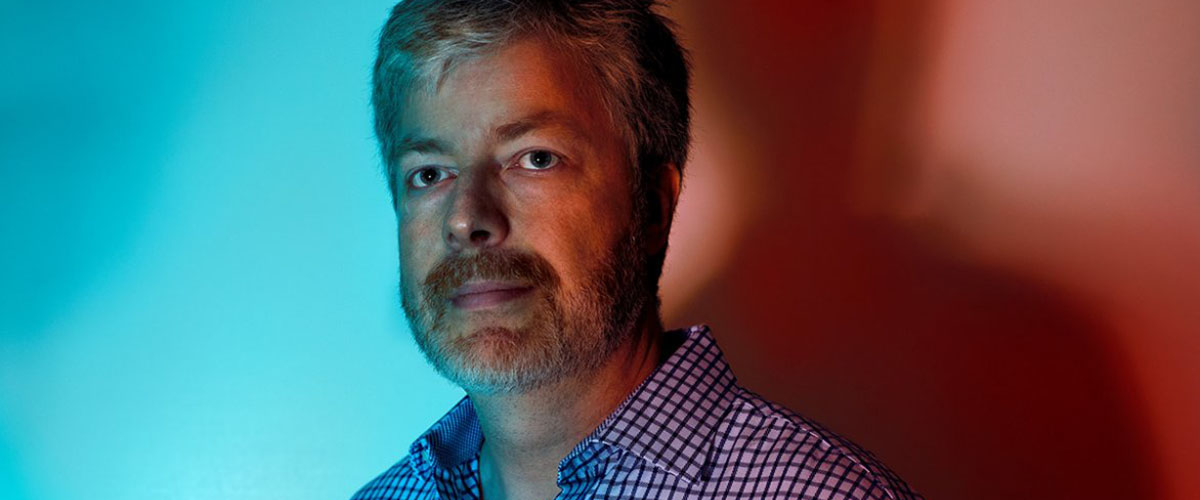You can’t find Peter Gor’kov’s work in the Louvre or The Met. But perhaps you should.
Gor'kov has always had an eye for beauty. As a boy growing up outside Moscow, he admired stylish things, sometimes crafting his own. Later, as a young tourist strolling through the street markets of Venice, he discovered the famed glassblowers of nearby Murano Island. Gor'kov marveled over their wares — some of the most delicate, ingenious and detailed objects he had ever seen. He was mesmerized by the artistry, the intricacy, the shininess. How could they put a glass fish inside a glass cat? How did they layer colors? How did they manage to assemble such beautiful things?
As Gor'kov described those fragile masterpieces decades later in his office at the National High Magnetic Field Laboratory, it was as if a little drawer suddenly sprang open in his brain. He framed his head with well-manicured hands, conveying how far beyond the confines of his skull his mind had been displaced by the sculptures. He felt a kinship with the artists who had conjured them.
"You want to do something that others around you can't do or don't understand how to," Gor'kov remembered. "You want to be different, basically."
Gor'kov never learned to blow glass. But he ended up an artist nonetheless, creating instruments called magnetic resonance probes that have been likened to Fabergé eggs. Researchers use these high-tech arms to place experiments in the cramped space at the center of magnets and retrieve data from the novel materials, proteins, complex macromolecules and animal models they study.

Young Peter with his parents, physicists Lev Gor'kov and Donara Gor'kova
Gor'kov, who has practiced his craft at the National MagLab for two decades, is considered a master. He became one by staking out a magical middle ground at the confluence of all the traits, disciplines and talents his work draws from. He inhabits a unique zone between engineering and science; academia and industry; mechanical and electrical engineering; theory and experiment. Physics, chemistry and biology intersect in this space, where hands and head play equally vital roles.
Gor'kov grew up among science luminaries. His father, Lev Gor’kov, was renowned for his work in the field of superconductivity and the recipient of numerous international awards in physics. In graduate school, Peter Gor'kov worked in the labs of another well-known physicist and a Nobel Prize-winning chemist. Yet through this forest of science giants, Gor'kov blazed his own trail, chasing something different, something gleaming, like a firefly's glint in the trees.
They don't hand out prizes for what Gor'kov does. After all, he's not the scientist, just one of the people who make the discoveries possible. But in the world where that science happens, Gor'kov's a rock star.
"He's quite a unique person who is very highly regarded in the field from people in academia as well as industry," said Tatyana Polenova, a professor of chemistry and biochemistry at the University of Delaware who uses Gor'kov's probes. His tools are easy to spot, she said, like a particular brand of luxury car speeding down the road. "You open his probes, you can see how impeccably things are put together."
Make or break an experiment
Scientists use strong magnets the same way they use microscopes: to see things they couldn't otherwise see. A probe is the equivalent of the microscope's slide — but with a lot more moving parts.
"Fields are useless without the probes," said Bill Brey, a physicist at the National MagLab who leads the instrumentation group in the nuclear magnetic resonance (NMR) spectroscopy and magnetic resonance imaging (MRI) program. "And in some cases, they are a lot more complex than the magnets themselves."
That is especially the case for NMR probes. In NMR, scientists use a combination of magnetic fields and radio frequency (RF) pulses to identify specific atoms in a sample — a huge, intricate protein, for instance. The technique is the same as is used in MRI machines, which send and receive RF pulses from hydrogen atoms in the body to create an image. As magnets have gotten stronger and instrumentation more sophisticated, scientists have gained access to a wider range of isotopes, including sodium, phosphorous and lithium. Thanks to a new world-record instrument at the National MagLab called the Series Connected Hybrid magnet, scientists can now even use NMR to study oxygen, the body's most biologically active isotope. This capability has opened the door to vast new areas of research.
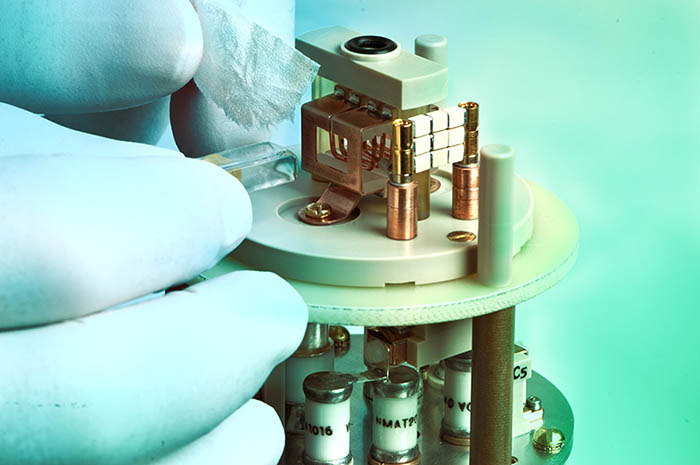
Probe #20: Gor'kovs groundbreaking "low-electric field" probe prevents heat from interfering with sensitive signals from proteins.
Photo: Dave Barfield
But getting those results requires packing a whole lot of complicated electronics into a soda can-sized container perched at the end of a long pole. Inside this probe, hundreds of tiny parts — pneumatic sample spinners, radio-frequency resonators, heaters, dewars, temperature sensors, fiber optics, screws, cables, capacitors, inductors, resistors — must be fastidiously assembled to allow for clear signals between the scientist and her science.
"The probe is where the business side of NMR really happens," explained Joanna Long, who oversees the National MagLab’s spectroscopy and imaging facility at its University of Florida branch.
That business, Long added, is tricky.
“You're putting in all these high-powered pulses, and then you're trying to get out these itty-bitty signals,” she explained. "It's like hitting a bell with a sledgehammer and waiting for one tiny note to come back. So you have to design something that is very robust and at the same time very sensitive."

He is the most detail-oriented and most meticulous person working in his area.
- William Brey
There is no one-size-fits-all NMR probe. Different experiments call for different models. Some are for solutions, some for solids; some for one isotope, some for another. There are probes that artfully insulate sensitive biological samples from damaging microwave heat; probes that keep rodents comfortably anesthetized during brain scans; and probes that spin samples around 100,000 times a second (6 million RPM) so that they emit clearer signals to scientists. Developing and building a state-of-the-art probe costs between $100,000 and $200,000, Brey estimated — and it's worth every penny.
"Because magnetic fields are so expensive, it's important that those probes work really well," Brey said. "The performance of the probe is just as important to the success of an experiment as the magnet itself."
A hair's breadth of metal on a probe can make the difference between good and bad data. That's why building one requires an uncommon mix of tenacity, ingenuity and spatial intelligence that, according to Brey, Gor'kov has in spades.
"He is the most detail-oriented and most meticulous person working in his area," Brey said.
Poking, prodding and blowing stuff up
Gor'kov can't recall a time when he wasn't itching to get his hands on a project.
"When I was a kid I always wanted to do something with my hands," he remembered. "It started with explosives, of course."
Peter and his young pals creatively sourced ingredients. They dug up decades-old stashes of bullets and artillery powder in the woods around Moscow, pilfered magnesium from retired aircraft used for target practice in war games. Once, while harvesting his shiny booty from an old helicopter, he glanced up to see a line of Soviet tanks headed straight his way. Terrified, Gor'kov tumbled to the ground and broke an arm. The soldiers were not pleased, but let him off with a good bawling-out.
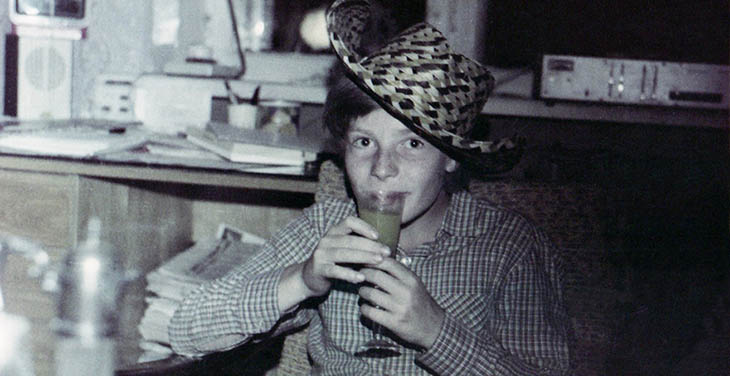
Peter at a birthday party in fifth grade. The next day he would break an arm during an adventure featuring old helicopters and Soviet tanks.
It wasn't the only time young Gor'kov's curiosity ran afoul of the rules. In defiance of his mother (like her husband, a physicist), he tried to repair his grandmother's watches. After getting one ticking again, he was emboldened to advance to a more valuable Swiss timepiece.
"I just opened up and I poked things inside," Gor'kov remembered. "I unscrewed everything, and I couldn't put it back together." Once again, the authorities were not amused; another bawling-out ensued.
Luckily, Gor'kov's Soviet education offered a constructive outlet for his urge to poke. (He began university in Moscow and continued in the U.S., where he and his parents relocated after the Soviet Union dissolved.) He did stints in labs, saw science in action during field trips and took classes in drafting, soldering, machining and general electronics. In one class, students were handed a schematic for a high-frequency amplifier and a bunch of parts. Their instructions: Figure it out.
"So you solder, solder, solder," Gor'kov recalled. "Then you come to the front where the teacher is sitting, and he plugs it in and says, 'Well, instead of an amplifier, it's an attenuator.'"
The student would slink back to his seat to start over.

Doing community service in a park during in eighth grade. Gor’kov recalls that he and his friends discovered old artillery powder in the process.
At the time, Gor'kov admitted, he probably hated the approach. But later in the U.S., when impressed classmates asked where he'd learned all that stuff, he understood its value.
"You keep making mistakes, but have to go back to it until it works," he said. "It was an amazing experience, because you learn it."
But Gor'kov was rarely satisfied with just making something work. He also needed to make it look good. He once modified his parents' rotary phone to look like the latest touchtone models — just because he thought they were cooler. Another time, seeking (unsuccessfully, as it turned out) to win points with a girlfriend, he made snazzy turn signals for her bike out of old car parts.
"That's what I kept doing all the time," he said. "I saw something that looked nice, and I tried to imitate it."
Gor'kov, however, seemed less gifted in the classroom. In chemistry class, he got a C — and "never did any better," he said. He fared even worse in physics, bringing home an F after his first course in seventh grade.
His inauspicious start in science may have been due to uninspired teaching, a subconscious aversion to subjects at which others in the family excelled, or just not taking schoolwork seriously.
Then again, Gor'kov said, "I never learned like other people did."
While explaining how he does learn, Gor'kov spoke slowly and softly, as is his practice. Though still heavily accented, his English is precise. You can almost see him gingerly poke about his brain to locate the mot juste then carefully lower it into position in his sentence. In fact, he conceives of learning spatially, as units you accumulate and store on a "shelf of knowledge" in your head, then retrieve as needed.
"I learned only those bits and pieces that were immediately necessary at the moment to complete a particular task," Gor'kov said. "And I would later learn other pieces elsewhere — the missing pieces. And then I would kind of say, 'Aha' — that now this little block falls into place and shows the whole picture.
“I’m still like that," Gor'kov concluded. "I’m learning by necessity."
And, sometimes, by the lure of beauty.
Small wonders
It was beauty, after all, that revised the boy's opinion about physics. It came in the shape of a blue and gold pin, featuring a bird and the symbol for Planck's constant, an important quantity in quantum physics.
"It was the tiniest pin of all I'd ever seen," Gor'kov said. "And I wanted it, because you had actually to work for it."
At the time, trading and collecting pins was popular among Soviet school children. To earn the particular pin he coveted, Gor'kov spent a year working on physics problems printed in a youth science magazine. After successfully solving them, the boy who would grow up to be an unassuming wizard of miniaturized circuitry won his bitty prize.
"All my friends had pins," he said. "Nobody had anything as small as this, because pins usually were made to stand out." For Gor'kov, its very restraint commanded attention.
Later, after emigrating to the U.S., Gor'kov eventually completed a master's degree in physics at the University of Illinois at Urbana-Champaign. But he was about as inspired by his classes as he was by the drab building they were taught in. Where his professors dove deep into theories and equations, he wanted to go broad. Where they focused on book learning, he craved hands-on work. He felt restless, like an eager student of French who is taught only verb conjugations.
"You want to learn the language and go use it," he said. "You want to have it as a tool and do something with it."

If you ever make a device that doesn't work, make sure it has a good coat of paint.
Gor'kov found consolation in the lab of his advisor, internationally recognized physicist and NMR pioneer Charles Slichter. There he learned to build basic NMR tools, he later admitted, "with maybe unnecessary accuracy."
He then moved to the lab of Paul Lauterbur, a chemist later awarded a Nobel Prize for discoveries concerning MRI; he learned to build the MRI coils used to generate images of the animals or tissues scanned inside them. Gor’kov took to heart a lesson he said came straight from the laureate’s lips: "If you ever make a device that doesn’t work, make sure it has a good coat of paint."
A few years later, the National MagLab's Brey lured him to the facility's headquarters in Tallahassee, Fla., where the senior Gor'kov was already ensconced as a founding scientist. Brey was trying to build up the nascent NMR facility, which featured one of the world's most powerful NMR machines at the time — an 830 MHz spectrometer for experiments on solids. But the instrument sat largely unused: There were no reliable probes to give scientists access to its 19.6-tesla magnetic field.
Gor'kov had spent years working on MRI instrumentation, but had never before built a solid state probe. So he did what he always does.
"I dive in and I learn on the go," he said.
"Let's take it apart and see."
One day last spring, MagLab physicist Victor Schepkin walked into the MagLab's probe workshop clutching a copper-clad canister. Schepkin has helped pioneer a technique called sodium MRI, which tracks the movement of salt in the brain in real time. In this way, using a world-record MRI machine at the MagLab, he can monitor how rats with brain tumors respond to chemotherapy. If he sees sodium leaving the cancer cells, he knows those cells are dying. If scientists eventually are able to scale this technique to humans, oncologists would know far sooner than is now possible if a patient's chemotherapy is working.
On this day, however, Schepkin complained that his most recent experiment had been a bust. Dark shadows were cropping up on his MRI images: He suspected something was wrong with the RF coil.
Now Gor'kov, clad in his usual baggy jeans and plaid flannel button-down, was bent over a workbench in the probe lab, fingering the canister like a Rubik's cube. To jog his memory, diagrams from the probe's patent paperwork were spread out on the surface below. After all, this instrument had been created many years and dozens of probes ago, well before the white now halfway across Gor'kov's ginger beard had made its first incursions.
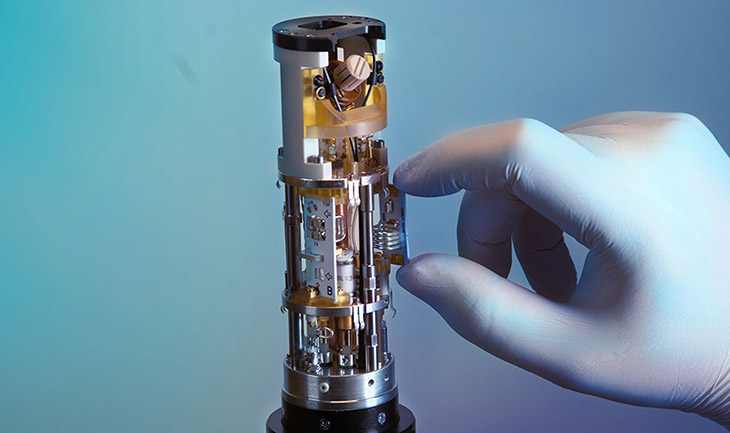
Probe #58: This ultra-fast magic-angle spinning probe, Gor'kov’s most recent creation, features a container that spins protein samples inside a magnet 100,000 rotations per second.
Photo: Stephen Bilenky
A postdoctoral researcher perched at his left, glued to his every word and move. Gor'kov connected the coil's tuning mechanism to an analyzer to check its resonance frequency. But on the screen, instead of a single peak corresponding to one frequency, there were two.
Gor'kov stared, trying to tune in to the answer. He sighed.
"Some asymmetry," he mused as the postdoc leaned in to catch his words. "Let's take it apart and see."
Learn More About Gor’kov’s Probes
Donning a magnifying visor, Gor'kov loosened several tiny screws to free the coil from its casing. He then poked delicately at a millimeter-wide ring of copper tape that scientists could slide up and down the coil to fine-tune its frequency.
He spotted a slit in the soldering — a clue, perhaps? "I'm curious what will actually happen if I force the crack," he pondered.
The postdoc fetched a razor blade, and Gor'kov sliced the shiny tape, which fell to the workbench like a curlicue of holiday ribbon. Gor'kov plucked it up, examined it.
Some years ago, Gor'kov was struggling with another stubborn problem: a probe that, scientists complained, was not sensitive enough and that was sending heat into their proteins, boiling them like a microwave oven. After months of work and little to show for it, he was mulling the puzzle over in the shower, scanning his mental archives for clues. He retrieved: a random conversation with a spectroscopist at some conference; sound bites from a presentation by a probe manufacturer that he had not understood at the time; and a few pages from a decades-old textbook. The clues snapped together in his brain, leading him to a different arrangement of RF coils for what became Gor’kov probe No. 20. The Low-E probe (the E is for the electric field, the culprit that had been cooking the samples), later commercialized by Bruker Corp., was the tool University of Delaware biochemist Polenova later used to study HIV-1 virus proteins. Because the proteins' high salt content readily conducts heat, other NMR probes had never worked for Polenova’s research. But this new probe, ingenious and sleek, did the trick for her tricky proteins.
"We put the sample in, and we were able to get beautiful data," she said. "It was a game changer."
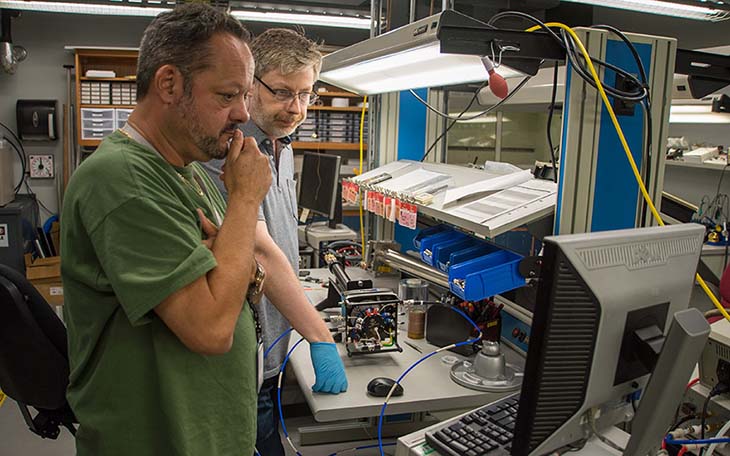
Research engineer Steve Ranner (left) and Gor'kov in the probe lab.
Photo: Stephen Bilenky
Gor'kov has recently begun work on two new probes — No. 59 and No. 60 — that pose a whole new level of challenge. They will be for the lab's new Series Connected Hybrid, which operates at much higher magnetic fields and resonance frequencies than any NMR magnet before it, said Tim Cross, director of the National MagLab's Tallahassee-based NMR/MRI Facility. Gor’kov, Cross said, is the person for the job. "He's fantastic at this."
Back in his lab, Gor'kov was trying to get to the bottom of the funky sodium coil. He rose from his stool, went straight to a little plastic drawer labeled "Copper Foil Tapes." He tugged it open, fished one out to replace the one he had just cut.
At that moment, research engineer Steve Ranner walked into the lab. He had had first crack at fixing the coil, but, seeing no obvious problem, asked its inventor to take a look. Now, a bit taken aback, Ranner surveyed its pieces, scattered across the table like shards of Venetian glass.
"I asked Peter to help and now it's all in bits," he said. "I'm worried maybe I shouldn't have asked."
But Gor'kov wasn't worried. He knew, with enough poking, he would sort it all out.
Story by Kristen Coyne



